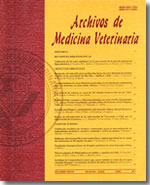Distribution, epidemiological characteristics and control methods of the pathogen Nosema ceranae Fries in honey bees Apis mellifera L. (Hymenoptera, Apidae)
Main Article Content
Abstract
Up until a few years ago, the microsporidian parasite Nosema ceranae was considered to be a pathogen of Apis cerana exclusively; however, only recently it has shown to be very virulent to Apis mellifera. Therefore, it has been named as apathogenic agent active in the disappearance of honey bee colonies globally, infecting all members of the colony. Honey bees are widely used for pollination and honey production, hence their importance in agriculture. They also play an important ecological role in plant pollination: a third of human food crops are pollinated by bees as well as many plants consumed by other animals. In this context, the object of this review is to summarise the information published by different authors on the geographical distribution and the morphological and genetic characteristics of this parasite, the symptomatology of the disease and the control methods used in those countries where N. ceranae is present, in order to identify better tools to confront this new bee disease.

